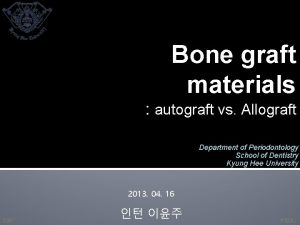Autogenous Shrinkage as a Viscoelastic Response to SelfDesiccation

- Slides: 1

Autogenous Shrinkage as a Viscoelastic Response to Self-Desiccation Zachary C. Grasley & David A. Lange MODEL BASICS MOTIVATION Why is autogenous shrinkage important? SModern concretes incorporate mineral admixtures and low w/c SHydration and pozzolanic reaction of these materials leads to selfdessication (internal drying that causes a reduction in internal RH) SReduction in RH reduction in capillary pressure bulk shrinkage SIf shrinkage is restrained, early-age cracking may be a significant problem SThe reduction in pore fluid pressure caused by self-desiccation and the development of curved menisci may be used by modeling the hardened cement paste as a solid with spherical pores Embedded pins for length measurement Saturated pore K 0 = viscoelastic non-ageing Strain indicator box Empty pore K = viscoelastic ageing SSince autogenous shrinkage and drying shrinkage are driven by the same mechanism, viscoelastic models for predicting autogenous shrinkage may be useful for predicting drying shrinkage as well EXPERIMENTAL RESULTS SThe approximate linear elastic solution for the strain in the model system is given by: S = saturation factor = pore fluid pressure determined by K-L equation and RH K = bulk modulus of porous solid K 0 = bulk modulus of solid material alone STo obtain the viscoelastic solution, the transform analogy may be used SViscoelastic stiffness parameters are shown with a bar SShrinkage is simply a response to pore pressure and is analogous to any other loading such as uniaxial tension MECHANISMS SAs water is removed from small pores, curved menisci develop SThis causes a pressure reduction in the pore fluid which can be related to RH through the Kelvin-Laplace equation SIn low w/c materials, enough water is removed from small pores to cause curved menisci simply by hydration Viscoelastic Time Elastic Viscoelastic * * = pore fluid pressure RH = internal humidity R = univ. gas constant T = temp. in kelvins v’ = molar vol. of water Fig. 2: Autogenous shrinkage of 0. 25, 0. 30, and 0. 35 w/c pastes with SRA. SSince hardened cement paste exhibits instantaneous deformation plus some recoverable creep, some variation of the standard linear model should be used for the viscoelastic stiffness parameters SAging should be accounted for (e. g. solidification theory) Chemical shrinkage ensures some porosity remains even at a=1 0. 30 w/c Standard linear model Autogenous shrinkage Pores to 50 nm emptied Internal RH and pore fluid pressure reduced as smaller pores are emptied Fig. 2: Internal RH reduction in 0. 25, 0. 30, and 0. 35 w/c pastes with SRA. * Not an exact analytical solution for partially saturated material 0. 50 w/c Initial set locks in paste structure Fig. 2: Internal RH reduction in 0. 25, 0. 30, and 0. 35 w/c pastes. Stress Time “Extra” water remains in small pores even at a=1 Cement grains initially separated by water Stress Elastic Fig. 2: Autogenous shrinkage of 0. 25, 0. 30, and 0. 35 w/c pastes. Autogenous Shrinkage Constant Uniaxial Tension C-S-H Hydraulic pump and pressure regulator Hydrostatic creep test for determination of viscoelastic bulk modulus Internal RH measurement Fig. 1: RH (~stress) and shrinkage plots indicating probable viscoelastic response of hardened cement paste Are there any other uses for this model? C-S-H Flexible corrugated tubing for sealed, restraint-free measurement of autogenous shrinkage Embedment strain gage Why do we need a viscoelastic model? SHardened cement paste acts as a viscoelastic material under shrinkage stresses (see Fig. 1) STo accurately predict stress distributions in concrete caused by self-desiccation or drying, we need to determine the time-dependent stressstrain relationship MEASUREMENTS Autogenous shrinkage Viscoplastic Viscoelastic Instantaneous elastic Recoverable shrinkage Increasing degree of hydration Time FUTURE WORK SFinish hydrostatic creep testing SPredict autogenous and drying shrinkage strains using model SExpand model to determine stress development due to aggregate, external restraint, and moisture gradient SMeasure viscoelastic Young’s modulus to complete constitutive relations for hardened cement paste SUse FEM to apply model to more complex structures

